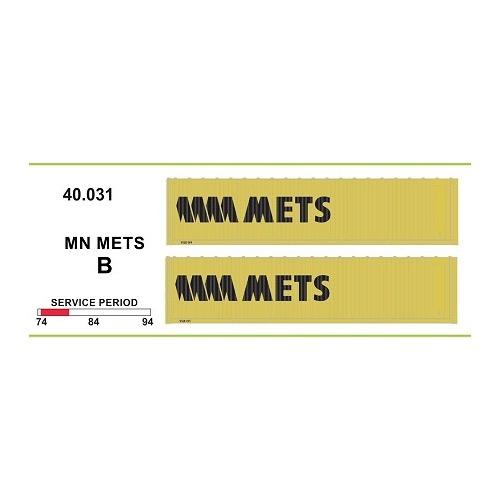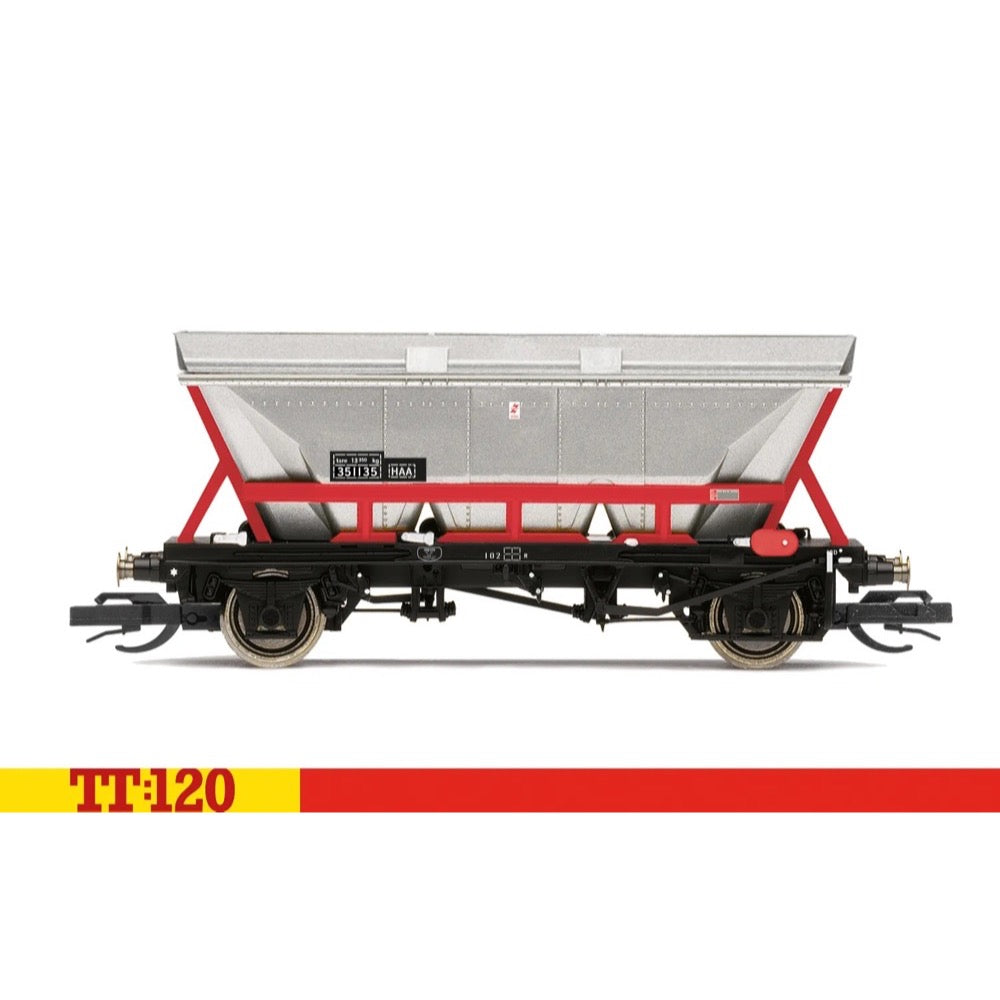
Hornby TT6013A TT HAA Hopper BR Railfreight
15.00
$
<p>Built from 1964 to 1977, HAA wagons were built as method to move coal more efficiently, particularly with the aim of improving to supply of coal to power stations. It was intended that trains of these wagons could run in a continuous loop from the colliery to the power station and back, with machinery in place to allow loading and unloading at slow speeds. In reality it was often the case that the infrastructure to allow this type of running did not exist, particularly at the collieries and on the loading side of the journey, but nonetheless these wagons greatly improved coal transfer. With the decline of Britain's coal industry these previously extremely common wagons have now become extremely rare with most having been either scrapped or rebuilt as another form of wagon.</p>
<h3>Specification</h3>
<ul>
<li>Item Length - Without Packaging (cm): 7.6</li>
<li>Item Height - Without Packaging (cm): 2.8</li>
<li>Item Width - Without Packaging (cm): 1.9</li>
<li>Item Weight - Without Packaging: 0.01</li>
<li>Item Scale: 1:120 Scale</li>
<li>Finish: Painted</li>
<li>Colour: Silver</li>
<li>Gauge: TT</li>
<li>Operator: BR</li>
<li>Designer: BR</li>
<li>Livery: BR</li>
<li>Minimum Curve (mm): Radius 1</li>
<li>Number of Parts: 1</li>
</ul>
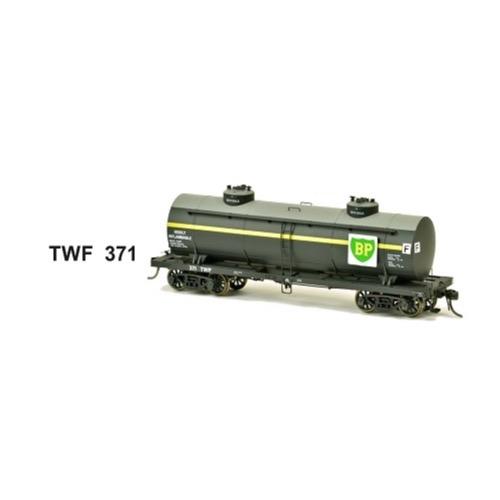
SDS Models HO VR TWF 10000 Gallon Tank Car TWF 371 BP
29.00
$
<h3>10000 Gallon Rail Tank Car Series</h3><p>SDS Models is producing a range of 10 000 gallon rail tank cars based upon a standard VR design 38 foot welded underframe. These HO Gauge models are presented with four unique, oil company specific, tank designs and accurately portrait the prototypical differences between each companies versions to meet their intended requirements. The models cover all major brands used in Victoria with the exception of the Shell Oil Company whose fleet rode on 36 foot riveted underframes.</p><h3>The models are available in triple-packs and are categorised into three groups:</h3><ul>
<li>OT - as delivered in the early 1950s to the early 1960s</li>TW / TWF - 1960s to the late 1970s<li>VTQA / VTQF / VTQY - 1980s and 1990s.</li>
</ul><h3>Model Features:</h3><ul>
<li>Highly detailed Ready-to-Run HO scale model</li>
<li>Injection moulded high quality plastic body</li>
<li>Etched metal walkways</li>
<li>Full brake rigging and underfloor detail</li>
<li>Semi scale metal rimmed wheels</li>
<li>OT bogie, 5’11” wheelbase with 36" diameter wheels.</li>
<li>Genuine Kadee #158 whisker coupler</li>
<li>18” Minimum radius recommended</li>
</ul>
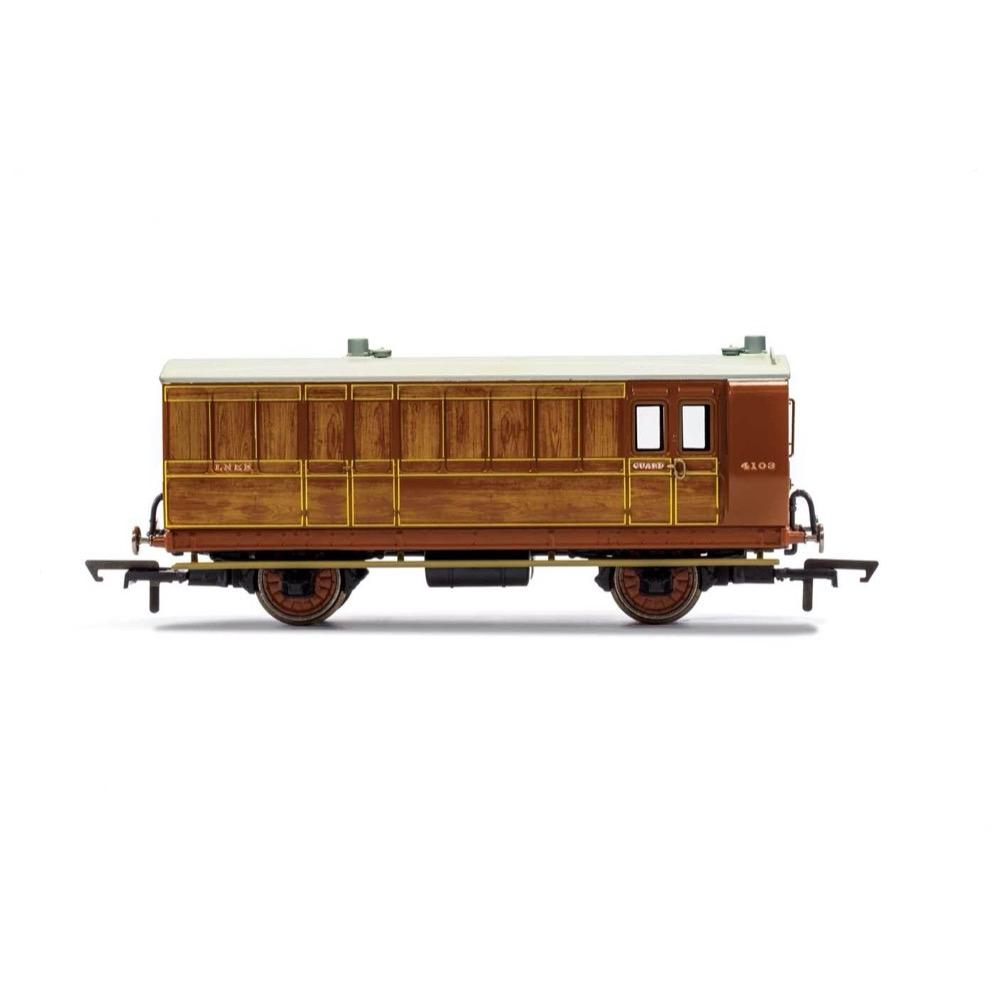
Hornby R40084 OO LNER4 Wheel Coach Brake Baggage 4103
32.00
$
<p>This four-wheeled coach is a representation of the many which served on the London and North Eastern Railway (LNER) having been inherited form the Great Northern Railway (GNR).</p>
<p>Small coaches such as this four-wheeled coach proved especially good at branch line work where their small size enabled the traversing of tight radius curves, whilst lower passenger numbers meant their small size was more acceptable and enabled trains to be hauled by smaller engines.</p>
<p>This LNER coach is modelled as having step boards to enable access at stations with low platforms and oil lamp lighting.</p>
<h3>Specification</h3>
<ul>
<li>Item Length - Without Packaging (cm): 13.5</li>
<li>Item Height - Without Packaging (cm): 5</li>
<li>Item Width - Without Packaging (cm): 3.5</li>
<li>Item Weight - Without Packaging: 0.06</li>
<li>Item Scale: 1:76 Scale 00 Gauge</li>
<li>Finish: Painted</li>
<li>Colour: Brown</li>
<li>Gauge: OO</li>
<li>Operator: LNER</li>
<li>Designer: LNER</li>
<li>Livery: LNER</li>
<li>Minimum Curve (mm): Radius 2</li>
<li>Number of Parts: 1</li>
</ul>
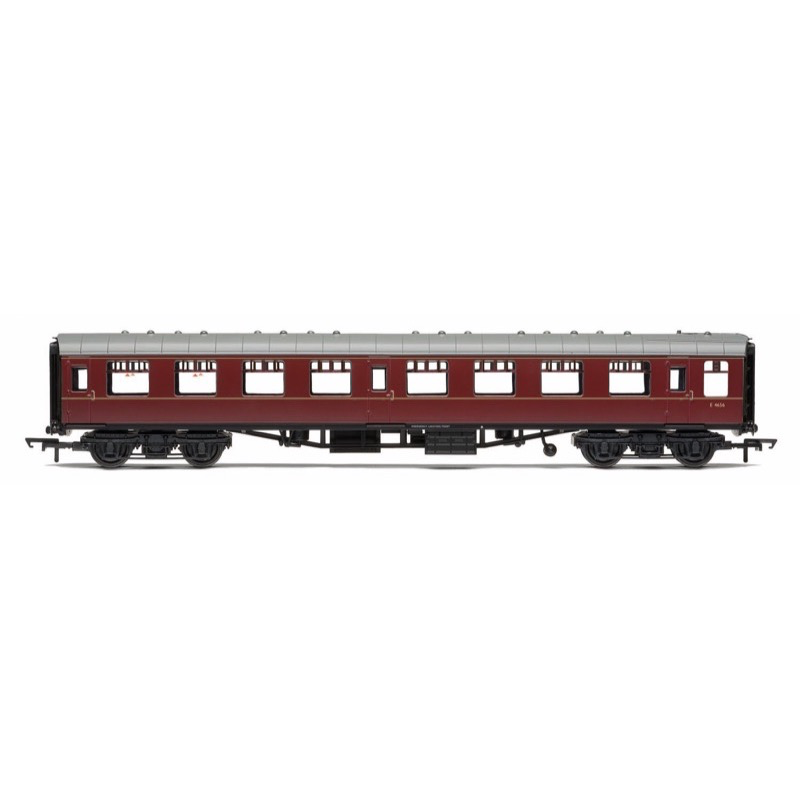
Hornby R4787 OO BR Mk1 Coach Tourist Second Open Maroon
42.00
$
<p>Designed by R.A Riddles (The Mechanical & Engineering Member of the Railway Executive) and aided by E. Pugson (Carriage & Wagon Chief Officer) and E.S Cox (Design Chief Officer), the Mark I carriage had a separate body and underframe, with a standard body length of 64ft 6in, an underframe 63ft 5in long and bogies at 46ft 6in centres. Body width was eventually settled at 8ft 8in, at cantrail height. The stock was introduced in 1951, in sets, on 'Festival of Britain' trains being built through to 1964, when superseded by the Mark II design. The Brake Second Open (BSO) consists of a standard class open passenger saloon, with a centre aisle, a guard's compartment with hand brake and a lockable luggage compartment, and was built between 1955 and 1963 to two diagrams: 183 and 184. 181 examples were built in total, 163 examples of Diag.183 and eighteen Diag.184 examples (which differed in having Commonwealth Bogies, Fluorescent Lighting and a door separating the sixteen non smoking seats from the twenty three smoking seats). The early deliveries went to the ER/NER and WR, with the ScR batch arriving in 1959. Long-lasting, they ran in crimson and cream, chocolate and cream, lined maroon, and blue/grey. The First Open (FO) consists of a first class open passenger saloon with a centre aisle and 119 examples of the Diag. 73 were built between 1951 and 1963 (seventeen similar Diag. 72 examples differed in having the middle doors central, with half windows each side and seating re-arranged with no central table). Early allocation was split between Eastern, Midland and Southern regions, with later allocations including Western and Scottish regions. Some examples went on to become Heritage/VIP charter stock and were liveried in Intercity colours.</p>
<h3>Specifications</h3>
<ul>
<li>Item Length - Without Packaging (cm): 31</li>
<li>Item Height - Without Packaging (cm): 4.5</li>
<li>Item Width - Without Packaging (cm): 9</li>
<li>Item Weight - Without Packaging: 0.19</li>
<li>Item Scale: 1:76 Scale 00 Gauge</li>
<li>License: No</li>
<li>Finish: Painted</li>
<li>Colour: BR Maroon</li>
<li>Gauge: OO</li>
<li>Operator: British Railways</li>
<li>Designer: British Railways</li>
<li>Livery: Maroon</li>
<li>Number of Parts: 1</li>
</ul>
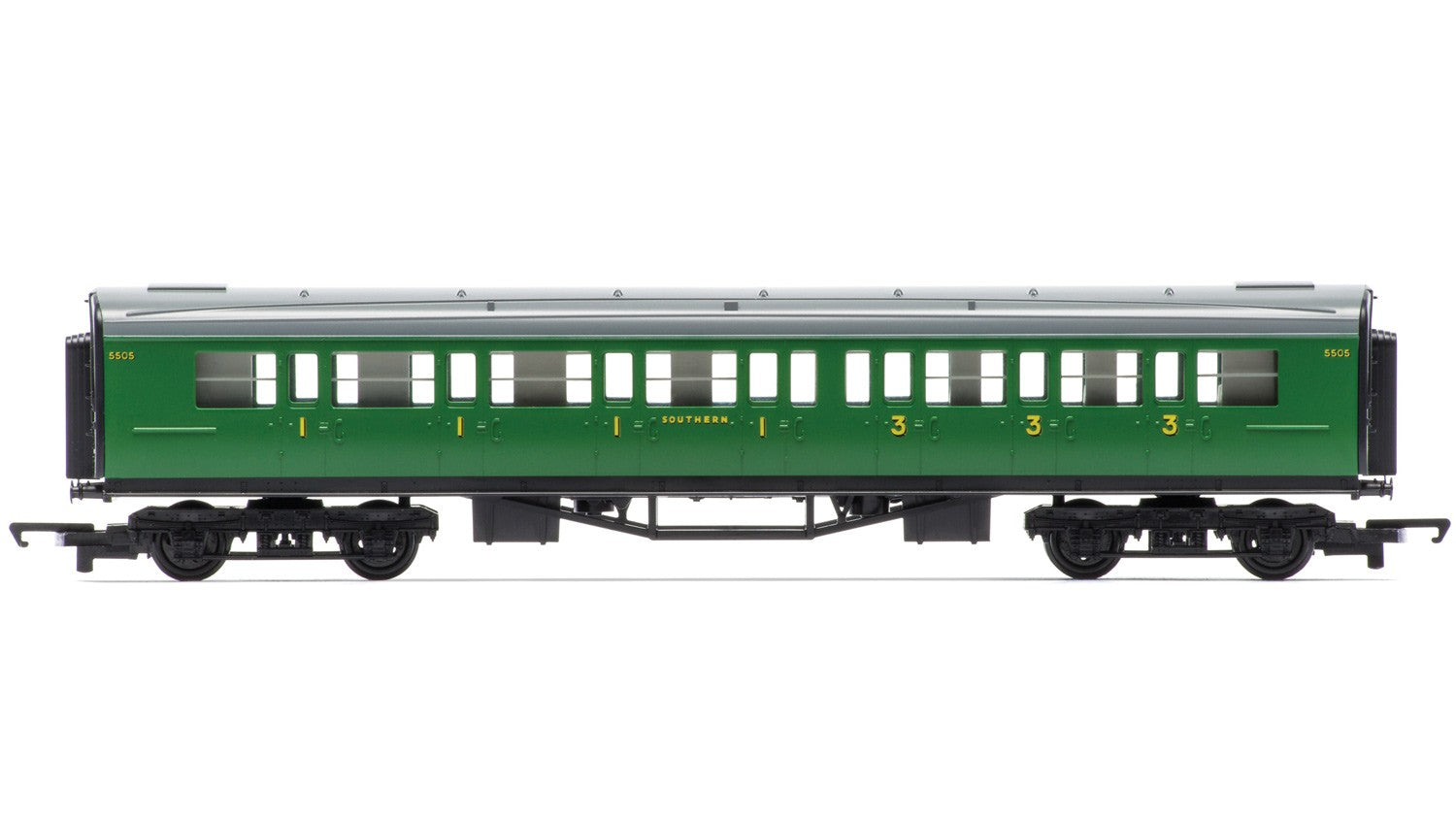
Hornby R4743 OO RailRoad SR Composite Coach
26.00
$
<p>R4743 Maunsell composite in SR malachite green - Railroad Range</p>
<h3>Specifications</h3>
<ul>
<li>Body Construction: Plastic</li>
<li>Chassis construction: Lightweight</li>
<li>Coupling socket/mounting: Fixed</li>
<li>Coupling type: Tension lock</li>
<li>Minimum radius: Radius 2</li>
</ul>
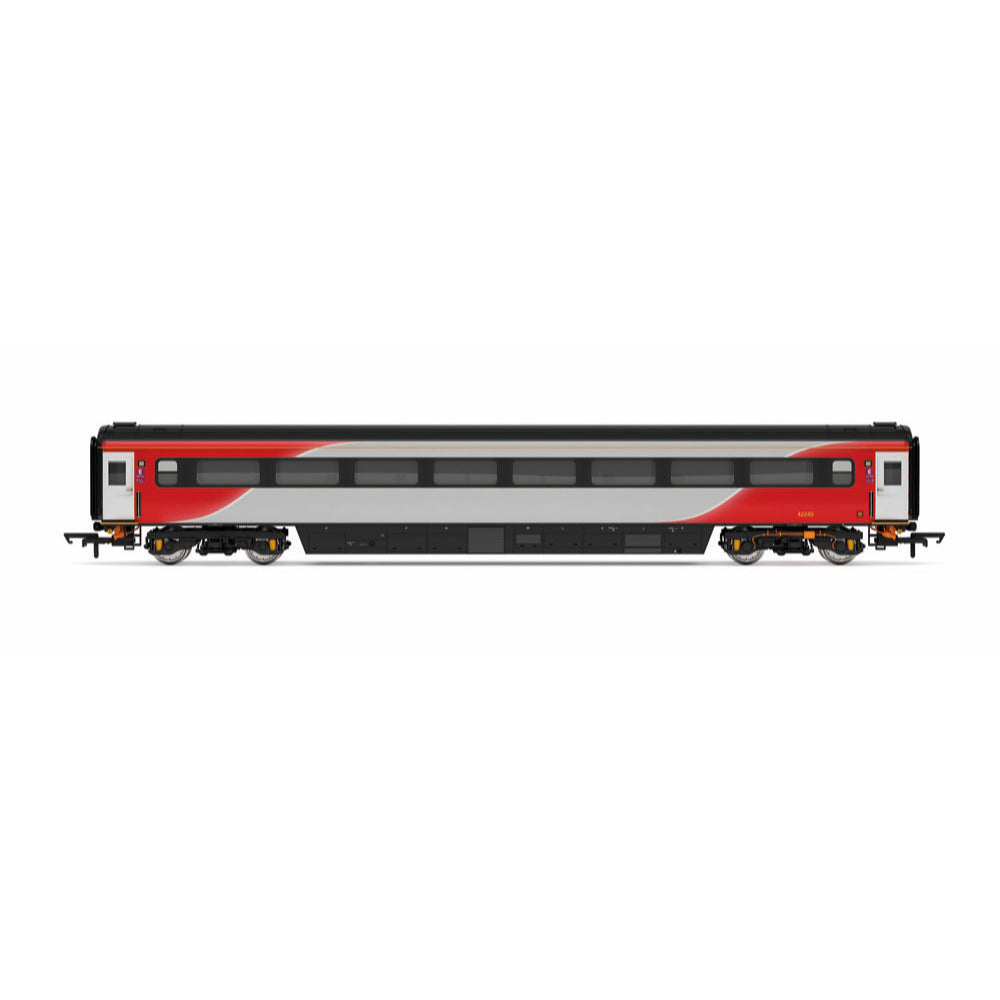
Hornby R40249A OO LNER Mk3 Trailer Standard 42198
32.00
$
<p>LNER inherited a large fleet of IC 125 and IC 225 sets from InterCity East Coast, but quickly began replacing the stock with more modern Hitachi built high-speed multiple units. The last IC 125 train operated by LNER ran as part of a farewell tour at the end of 2019.</p>
<h4>Includes</h4>
<ul>
<li>1x Rolling stock Coach</li>
</ul>
<h4>Technical Specifications</h4>
<div>
<ul>
<li>Item Length - Without Packaging (cm): 30.3</li>
<li>Item Height - Without Packaging (cm): 5</li>
<li>Item Width - Without Packaging (cm): 3.5</li>
<li>Item Weight - Without Packaging: 0.19</li>
<li>Item Scale: 1:76 Scale 00 Gauge</li>
<li>License: Yes</li>
<li>License line: Produced under license for SCMG Enterprises Ltd. ©SCMGE.</li>
<li>Finish: Painted</li>
<li>Colour: Red</li>
<li>Operator: LNER</li>
<li>Designer: BREL</li>
<li>Livery: LNER Red</li>
<li>Minimum Curve (mm): Radius 2</li>
<li>Number of Parts: 1</li>
</ul>
</div>
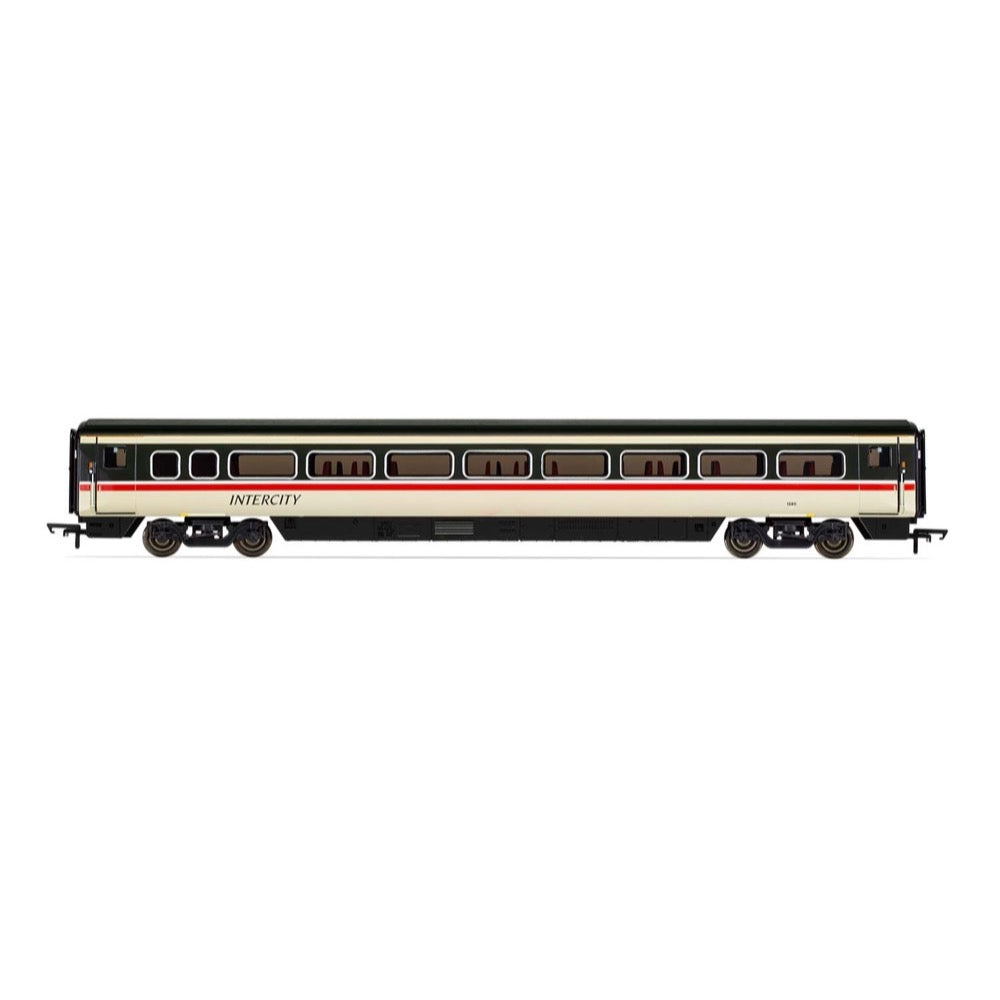
Hornby R40156 OO BR Mk4 StandardCoach E
40.00
$
<p>Built at Metro-Cammell's Washwood Heath factory, 314 Mk4 coaches were produced between 1989 and 1992. They were built specifically for use on the newly electrified East Coast Main Line, along with hopes that a second order for the West Coast Main Line would be placed at a later date, although this second order never transpired. Mk4 coaches featured many improvements over the Mk3s such as push-button operated plug-type doors, fully sealed gangways and a designed top speed of 140mph. Much of the Mk4 design was based upon the Advanced Passenger Train. In particular, Mk4 coaches feature sides profiled to allow a tilt of up to 6° with newly fitted tilting bogies.</p>
<p>Mk4ss entered service in 1989 and helped drive a significant increase in passenger traffic. With privatisation in 1996, all Mk4 coaches were sold to Evershot Rail Group who have since leased them out to the holder of the InterCity East Coast Franchise. The franchise was initially awarded to Great North Eastern Railway (GNER) and has since been operated by National Express East Coast, East Coast, Virgin Trains East Coast and London North Eastern Railway (LNER) owned by the Department for Transport.</p>
<p>Between October 2003 and November 2005 Bombardier Transportation, under contract from GNER, commenced refurbishment of the Mk4 stock, fitting new seating arrangements and introduced onboard Wi-Fi, a first for British rail services. This refurbishment programme was called 'Project Mallard' named after the Mallard steam locomotive, built in the 1930s by the London & North Eastern Railway and holder of the world speed record for steam locomotives.</p>
<p>Although Mk4 coaches have spent most of their lives on the ECML, there are plans to cascade them down to other lines due to the introduction of the Class 800 and Class 801 IEPs.</p>
<h3>Specification</h3>
<ul>
<li>Item Length - Without Packaging (cm): 33</li>
<li>Item Height - Without Packaging (cm): 5</li>
<li>Item Width - Without Packaging (cm): 3.5</li>
<li>Item Weight - Without Packaging: 0.2</li>
<li>Item Scale: 1:76 Scale 00 Gauge</li>
<li>Finish: Painted</li>
<li>License: No</li>
<li>Colour: Grey</li>
<li>Gauge: OO</li>
<li>Operator: BR</li>
<li>Designer: Met Cam</li>
<li>Livery: BR</li>
<li>Minimum Curve (mm): Radius 2</li>
<li>Number of Parts: 1</li>
</ul>
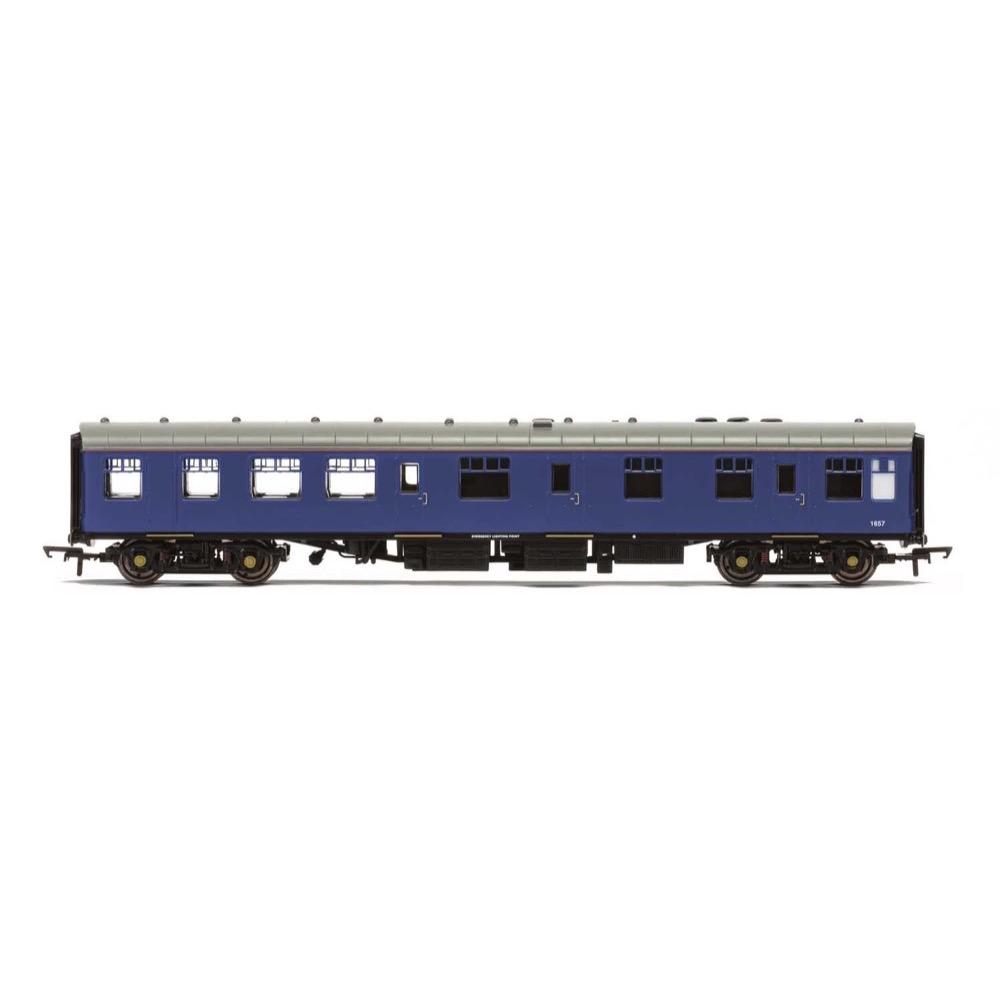
Hornby R40027 OO DRS Mk1 Restaurant Buffet 1657
37.00
$
<p>The first standardised railway carriage design built by British Railways, the Mark 1 coach introduced in 1951 could be found across Britain's railway network and continued to be produced until 1963, and even later in the form of multiple units and non-passenger stock. Along with being widely deployed, Mk1 coaches were built in various places including Derby, Doncaster, Eastleigh, Swindon, Wolverton and York.</p>
<p>Most Mk1 coaches had 63ft 5in long underframes with 64ft 6in long bodies, although some were built shorter to be used on tighter curves where large overhangs would otherwise have prohibited running. In 1977 a reduction in the number of fatalities on British railways since 1955 was attributed to the introduction of the Mk1 coaches due to their steel build, strong underframe, and buckeye couplings making them far safer in the event of an accident.</p>
<p>Mk1 coaches started to be withdrawn from widescale service in the 1990s, although in some regions, particularly in the south, Mk1 base multiple units continued to be used well into the 2000s. Network rail continue to use modified Mk1 coaches for various departmental duties and rail tour operators continue to use Mk1 coaches on specially organised services.</p>
<p>The Mk1 RB is a Mk1 Restaurant Buffet coach containing a kitchen and a serving buffet counter. As well as these features the coach would also feature seating, usually with a capacity of 23 passengers. The first phase of building British Railways' Mk1 catering vehicles followed the traditional pattern of dining that had been catered for since Edwardian times, with large Kitchen Cars preparing multiple course dining for consumption in both First and Third Class Dining Cars. However, during the early 1950s it became apparent that social patterns regarding rail travel catering were changing, a direct consequence of WWII attitudes towards dining.</p>
<p>The catering department of British Railways was experiencing a demand from travellers for cheaper and lighter meals and was seeing an increase in social drinking that was not related to dining. This change in dining patterns meant that the use of a Buffet vehicle, rather than a full Kitchen Car/Dining Car combination, was sometimes a better option and the third phase 1957-62 Mk.1 building programme provided many of BR's vehicles with buffet facilities, not just in addition to full meal provision, but also replacing it. Propane gas units were used for gas cooking, reducing the reliance on electric power which, in turn, allowed for a smaller dynamo and battery.</p>
<h3>Specification</h3>
<ul>
<li>Item Length - Without Packaging (cm): 26.5</li>
<li>Item Height - Without Packaging (cm): 5</li>
<li>Item Width - Without Packaging (cm): 3.5</li>
<li>Item Weight - Without Packaging: 0.14</li>
<li>Item Scale: 1:76 Scale 00 Gauge</li>
<li>License: No</li>
<li>Finish: Painted</li>
<li>Colour: Blue</li>
<li>Gauge: OO</li>
<li>Operator: DRS</li>
<li>Designer: BR</li>
<li>Livery: DRS</li>
<li>Minimum Curve (mm): Radius 2</li>
<li>Number of Parts: 1</li>
</ul>
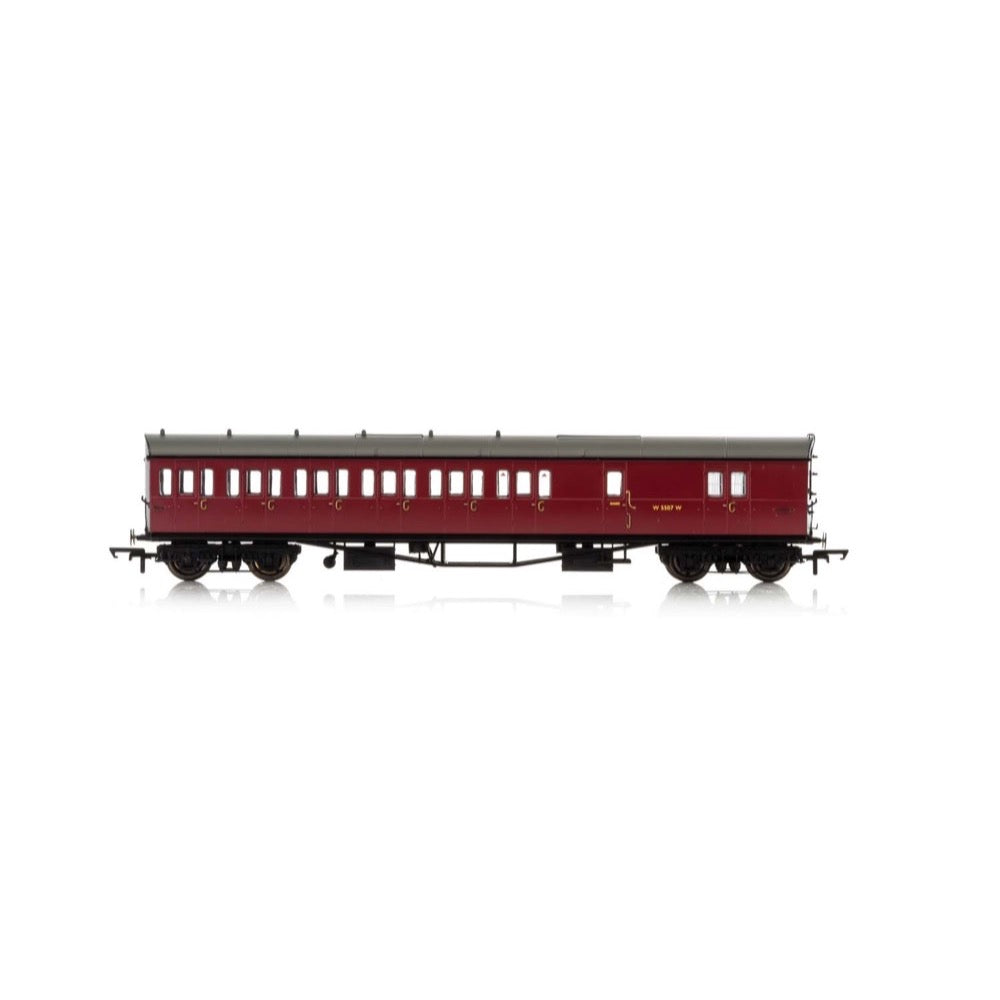
Hornby R4880A BR Collett 57 Bow Ended D98 Six Compartment Brake Third Left Hand W4949W - Era 4
47.00
$
<p>BR, Collett 57' Bow Ended D98 Six Compartment Brake Third (Left Hand), W5507W - Era 4 measures in at 242mm, features a maroon/crimson livery and is without a doubt any railway collector's staple coach. Let's not forget being a much appreciated gift as well, so be sure to pick yours up today!</p>
<p>Specification<br>
Item Length - Without Packaging (cm): 31.5<br>
Item Height - Without Packaging (cm): 4.5<br>
Item Width - Without Packaging (cm: 9<br>
Item Weight - Without Packaging: 0.22<br>
Item Scale: 1:76 Scale 00 Gauge<br>
License: No<br>
Finish: Painted<br>
Colour: BR Crimson<br>
Gauge: OO<br>
Operator: British Railways<br>
Designer: Charles Collett<br>
Livery: Maroon<br>
Number of Parts: 1</p>


